Mj Waters
-
- 38th Annual CSSRA Conference And First Canadian Shipbuilding & Offshore Exhibition Maritime Reporter, Jan 15, 1986 #12
Montreal, February 10-11All speakers and topics have been confirmed for the open sessions of the 38th Annual Technical Conference of the Canadian Shipbuilding and Ship Repairing Association (CSSRA). To be held Monday, February 10 and Tuesday, February 11 in Montreal's Queen Elizabeth Hotel, the conference is expected to attract members of the marine community from across Canada and around the world, says CSSRA president Henry Walsh.
This CSSRA annual meeting is the largest and best-known marine technical event in Canada. Last year it drew an attendance of more than 800, including Canadian government officials and the international marine media.
Mr. Walsh notes that this year's conference will include the firstever Canadian Shipbuilding & Offshore Exhibition (CSOE '86), which is expected to attract large numbers of exhibitors to display and demonstrate their products and services to the marine and offshore industries.
The exhibition, to be held on the convention floor just outside the conference meeting rooms at the Queen Elizabeth, will be open from 3 to 7 pm on February 10 and from 10 am to 5 pm on February 11.
Of the estimated $5-billion cost of developing the Hibernia oil project offshore Newfoundland, some 50 percent will be marine-related. This demand, Mr. Walsh said, could mean employment opportunities and spin-off industrial benefits if sourced in Canada, as well as opportunities for companies in the U.S.
and other countries in the form of joint ventures.
The technical conference begins at 9 am on February 11, and will be open to all interested parties. Concurrent presentations will continue throughout the day in the adjacent Duluth and Joilet meeting rooms.
Copies of the papers presented will be available in bound form from the CSSRA registration desk at the hotel.
The meeting will conclude with a banquet in the Grand Salon beginning at 7:30 pm.
Technical Conference Tuesday, February 11 Duluth Room Chairman: M.J. Waters, chairman, CSSRA Technical Section.
9:00 am: "Modern Shipbuilding Methods Applied to Construction of Canadian Coast Guard 1100 Navaids Vessels," by Don Challinor, president and CEO, Versatile Pacific Shipyards.
"Productivity's Essential Ingredient," by Arthur J.R. Smith, chief executive officer, Canadian Labour Market and Productivity Centre.
Coffee Break 10:30 am: "The Application of Advanced Design and Construction Techniques to the Canadian Patrol Frigate," by Peter E. Jaquith, vice president, Pre-Construction Activities & CPF program manager, and Gilbert Snyders, vice presi- dent & general manager-shipbuilding, Saint John Shipbuilding Ltd.
"Canadian Patrol Frigate (CFP) Combat System Testing," by Gerald M. Zutler, vice president, Paramax Electronics Inc.
12 Noon: Lunch 2:00 pm: "NRC Institute for Marine Dynamics—Your New National Facility," by N.E. Jeffrey, director, and D.C. Murdey, assistant director, Insitute for Marine Dynamics, National Research Council.
"Development of the B2400 Engine," by R. Dunton, director, Engine R&D, Rail and Diesel Power Division, Bombardier Inc.
3:30 pm: "The Application of Advanced Techniques to Hull Form Design and Analysis," by D.R. Patterson, head of sales, British Maritime Technology Ltd.
Joliet Room Chairman: I.L. Bateman, chairman, CSSRA Allied Industries Members.
9:00 am: "Reliability Assurance of Floating Production Systems," by T. Nasseri, S.J. Gorman and I.
Frazer, Det norske Veritas (Calgary, Montreal and Oslo, respectively).
"Computer-Aided Ship Design Process within VSEI," by Robert Leong, Versatile Systems Engineering Inc.
Coffee Break 10:30 am: "Canadian Frontier Oil & Gas Plays—What the Immediate Future Holds," by Ian M. Doig, editor, Doig's Digest and president, Ian M. Doig & Associates Ltd.
"Fracture Control Plan in the Fabrication of Offshore Structures for the Canadian East Coast," by Denis Larose, head, Welding & Metallurgical Department, Versatile Davie Inc.
12 Noon: Lunch.
2:00 pm: "Building Canada's Frontier— The Materials Factor," by J.W. Hotchkies, manager-market development engineering, The Algoma Steel Corporation, Ltd.
"The Importance of Shipping in the Canadian Arctic," by Charles Hetherington, president, Panarctic Oils Ltd. (to be presented by Lindsay J. Franklin, vice president, Operations Division, Panarctic Oils).
6:30 pm: Cash Bar, Joilet Room.
7:30 pm: Annual Banquet, Grand Salon.
-
 )
March 2024 - Marine Technology Reporter page: 44
)
March 2024 - Marine Technology Reporter page: 44NEW TECH OCEANOLOGY INTERNATIONAL 2024 Image courtesy Metron/Cellula Teledyne Marine acquires Valeport: Matt Quartley, MD, Valeport and Ole Søe-Pedersen, VP & Image courtesy Teledyne Marine GM Teledyne Marine announce the deal in London. Pictured (L-R): Cellula Robotics, President, Eric Jackson, Metron
-
 )
March 2024 - Marine Technology Reporter page: 43
)
March 2024 - Marine Technology Reporter page: 43Image courtesy Kongsberg Discovery Image courtesy Teledyne Marine New Products Teledyne Marine had its traditional mega-booth at Oi, busy start to ? nish. Image courtesy Greg Trauthwein offers quality sub-bottom pro? ling capability without the need tion of offshore windfarms. GeoPulse 2 introduces new
-
 )
March 2024 - Marine Technology Reporter page: 42
)
March 2024 - Marine Technology Reporter page: 42NEW TECH OCEANOLOGY INTERNATIONAL 2024 Image courtesy Greg Trauthwein Image courtesy BIRNS MacArtney launches the new ultra-compact ø12.7 mm SubConn Nano connector. Innovative connectivity built on 45 years of ? eld-proven and market-trusted design. Image courtesy MacArtney Birns celebrated its 70th
-
 )
March 2024 - Marine Technology Reporter page: 41
)
March 2024 - Marine Technology Reporter page: 41Image courtesy Outland Technology Image courtesy Exail Image courtesy Submaris and EvoLogics Vehicles The ROV-1500 from Outland Technology represents a leap forward in underwater robotics, a compact remotely operated vehicle (ROV) weighing in at less than 40 lbs (19kg) the ROV- 1500 is easy to transport
-
 )
March 2024 - Marine Technology Reporter page: 40
)
March 2024 - Marine Technology Reporter page: 40NEW TECH OCEANOLOGY INTERNATIONAL 2024 All photos courtesy MTR unless otherwise noted NEW TECH, PARTNERSHIPS LAUNCH IN LONDON With Oceanology International now one month in the rear-view mirror, MTR takes a look at some of the interesting technologies launched before, during and after the London event.
-
 )
March 2024 - Marine Technology Reporter page: 36
)
March 2024 - Marine Technology Reporter page: 36LANDER LAB #10 Of special interest for marine applications, LiPo batteries are Shipping any kind of lithium battery can be a challenge, and offered in a “pouch” design, with a soft, ? at body. The pouch IATA regs vary with the batteries inside or outside an instru- is vacuum-sealed, with all voids ?
-
 )
March 2024 - Marine Technology Reporter page: 35
)
March 2024 - Marine Technology Reporter page: 35Figure 1 A self-righting vehicle design with buoyancy high and weight low, WHOI’s SeaBED AUV captures the attention of a pair of curious Antarctic penguins as it is deployed from the British research vessel James Clark Ross. Vehicle designers allowed for temperature reduction of battery capacity. Recharge
-
 )
March 2024 - Marine Technology Reporter page: 33
)
March 2024 - Marine Technology Reporter page: 33regulated industry in the world.” How- ever, commercial success depends on many factors, not least a predictable OPEX. Over the past four years, SMD has worked with Oil States Industries to calculate cost per tonne ? gures for prospective customers. Patania II uses jet water pumps to Oil States’
-
 )
March 2024 - Marine Technology Reporter page: 30
)
March 2024 - Marine Technology Reporter page: 30FEATURE SEABED MINING bilical. It has passive heave compensation which nulli? es the necott. “The focus since then has been on scaling while en- wave, current and vessel motions that in? uence loads in the suring the lightest environmental impact,” says The Metals power umbilical. The LARS can
-
 )
March 2024 - Marine Technology Reporter page: 29
)
March 2024 - Marine Technology Reporter page: 29n January, Norway said “yes” to sea- bed mining, adding its weight to the momentum that is likely to override the calls for a moratorium by over 20 countries and companies such as I Google, BMW, Volvo and Samsung. Those against mining aim to protect the unique and largely unknown ecology of the sea?
-
 )
March 2024 - Marine Technology Reporter page: 25
)
March 2024 - Marine Technology Reporter page: 25Auerbach explained that ideally, “one ? ed layers of geothermal activity,” noted changes over an area of 8,000 km2. They would have both instruments: seismom- Skett, “and the change in salinity and dis- found up to seven km3 of displaced ma- eters to detect and locate subsurface ac- solved particles for
-
 )
March 2024 - Marine Technology Reporter page: 23
)
March 2024 - Marine Technology Reporter page: 23elatively inactive since 2014, the Hunga Tonga–Hunga Ha‘apai (HT-HH) submarine volcano began erupting on December 20, 2021, reaching peak intensity on January 15, 2022. This triggered tsunamis throughout the Pa- R ci? c, destroyed lives and infrastructure, and generated the largest explosion recorded
-
 )
March 2024 - Marine Technology Reporter page: 16
)
March 2024 - Marine Technology Reporter page: 16TECH FEATURE IMR Image courtesy FORCE Technology OPTIMIZING CATHODIC PROTECTION SURVEY USING NON-CONTACT SENSORS By Svenn Magen Wigen, FORCE Technology he principle behind sacri? cial anodes, which are water structures, reducing the need for frequent repairs and used to safeguard underwater pipelines
-
 )
March 2024 - Marine Technology Reporter page: 15
)
March 2024 - Marine Technology Reporter page: 15sensor options for longer mission periods. About the Author For glider users working in ? sheries and conservation, Shea Quinn is the Product Line Manager the Sentinel can run several high-energy passive and active of the Slocum Glider at Teledyne Webb acoustic sensors, on-board processing, and imaging
-
 )
March 2024 - Marine Technology Reporter page: 14
)
March 2024 - Marine Technology Reporter page: 14TECH FEATURE TELEDYNE SLOCUM GLIDERS to hold over 3.5 times as many lithium primary batteries as the the water column and its thrusters give it the ability to stay standard Slocum Glider, and to physically accommodate up to on track in strong currents or other dif? cult ocean condi- 8 different sensor
-
 )
March 2024 - Marine Technology Reporter page: 13
)
March 2024 - Marine Technology Reporter page: 13nyone familiar with glider hardware options integrated for a broad Glider answers that need,” said Shea autonomous underwater ve- range of missions. Quinn, Slocum Glider Product Line hicles (AUVs) is certainly “As the use of Slocum Gliders grew, Manager at TWR. A familiar with the popular- so did
-
 )
March 2024 - Marine Technology Reporter page: 9
)
March 2024 - Marine Technology Reporter page: 9from marinas along the western coast. The exact number of lizing laser detection systems can detect mines just below the mines, as well as their locations, remains largely a mystery, surface, even those hiding in murky water. The Airborne Laser although reports suggest that over three hundred have been
-
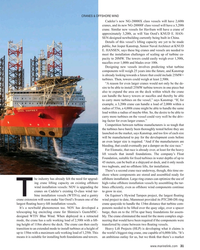 )
April 2024 - Maritime Reporter and Engineering News page: 31
)
April 2024 - Maritime Reporter and Engineering News page: 31CRANES & OFFSHORE WIND Cadeler’s new NG-20000X class vessels will have 2,600t cranes, and its new NG-20000F class vessel will have a 3,200t crane. Similar new vessels for Havfram will have a crane of approximately 3,200t, as will Van Oord’s KNUD E. HAN- SEN-designed newbuilding currently being built in
-
 )
April 2024 - Maritime Reporter and Engineering News page: 27
)
April 2024 - Maritime Reporter and Engineering News page: 27RADM PHILIP SOBECK, MILITARY SEALIFT COMMAND With COVID, we had to make some hard choices for our Do your CIVMARs have upward mobility? mariners because we couldn’t rotate. Many of our mariners The Navy has Sailors who become “Mustangs,” and work found other employment, and were able to use their skills
-
 )
April 2024 - Maritime Reporter and Engineering News page: 13
)
April 2024 - Maritime Reporter and Engineering News page: 13from gasoline to methanol, but compared to just buying an EV After some pondering, I think I can reduce it to this logi- today that is a pointless exercise. It would actually make more cal sequence: sense to buy a plug-in hybrid that is con? gured for methanol It is the carbon. We want zero carbon as
-
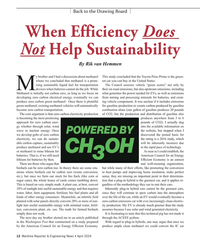 )
April 2024 - Maritime Reporter and Engineering News page: 12
)
April 2024 - Maritime Reporter and Engineering News page: 12Back to the Drawing Board When Efficiency Does Not Help Sustainability By Rik van Hemmen y brother and I had a discussion about methanol This study concluded that the Toyota Prius Prime is the green- where we concluded that methanol is a prom- est car you can buy in the United States. ising sustainable
-
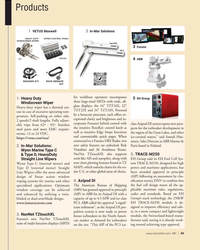 )
April 2024 - Marine News page: 43
)
April 2024 - Marine News page: 43Products 1 2 VETUS Maxwell In-Mar Solutions 3 Furuno ABB 4 for workboat operators encompasses EH Group 1. Heavy Duty 5 three large-sized MFDs with wide, all- Windscreen Wiper glass displays: the 16” TZT16X, 22” Heavy-duty wiper has a thermal cut- TZT22X and 24” TZT24X. Powered out in
-
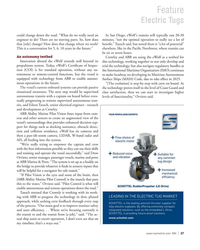 )
April 2024 - Marine News page: 37
)
April 2024 - Marine News page: 37Feature Electric Tugs could change down the road. “What do we really need an In San Diego, eWolf’s transits will typically run 20-30 engineer to do? There are no moving parts. So, how does minutes, “not the optimal operation to really see a lot of that [role] change? How does that change where we work?
-
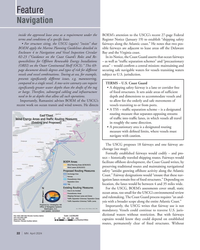 )
April 2024 - Marine News page: 22
)
April 2024 - Marine News page: 22Feature Navigation inside the approved lease area as a requirement under the BOEM’s attention to the USCG’s recent 27-page Federal terms and conditions of a speci? c lease. Register Notice (January 19) to establish “shipping safety • For structure siting, the USCG (again) “insists” that fairways along
